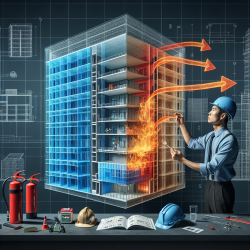Understanding Heat Transfer Models in Fire Safety
In the realm of structural design, ensuring fire safety is paramount. The research article "A Review of Models for Heat Transfer in Steel and Concrete Members During Fire" provides valuable insights into how heat transfer models can be effectively utilized to predict and improve the fire resistance of structural elements. This blog aims to distill key findings from the research and encourage practitioners to implement these insights or delve deeper into the subject.
The Importance of Accurate Temperature Prediction
Structural design for fire safety involves understanding how materials like steel and concrete behave under high temperatures. Accurate prediction of temperature changes in structural members during a fire is crucial for assessing their fire resistance. This requires a thorough understanding of both temporal and spatial temperature variations, which can be achieved through heat transfer analysis.
Models and Approaches
The research highlights several models ranging from simple analytical equations to advanced computational techniques such as finite element analysis (FEA). These models help in determining the transient temperature profiles in structural members exposed to fire, which is essential for performance-based design approaches.
- Simple Models: These include lumped mass approaches for steel and concrete, which assume uniform temperature distribution. They are useful for initial assessments and when computational resources are limited.
- Advanced Models: These involve detailed simulations using FEA or finite difference methods. They provide a more comprehensive understanding of heat transfer, accounting for complex geometries and material properties.
Practical Applications
Practitioners can apply these models to enhance the fire safety of buildings by:
- Using simplified models for quick assessments of fire resistance in steel and concrete members.
- Implementing advanced simulations for detailed analysis of critical structures, especially in performance-based design scenarios.
- Incorporating findings into building codes and standards to improve overall fire safety regulations.
Encouraging Further Research
While the existing models provide a solid foundation, there is always room for improvement. Further research can focus on:
- Developing more accurate models that account for complex fire scenarios and material behaviors.
- Exploring the effects of different fire protection measures on heat transfer in structural members.
- Enhancing computational techniques to reduce the time and resources required for simulations.
Conclusion
By understanding and applying heat transfer models, practitioners can significantly improve the fire resistance of structural elements, leading to safer building designs. Continued research and innovation in this field will further enhance our ability to predict and mitigate the effects of fire on structures.
To read the original research paper, please follow this link: A Review of Models for Heat Transfer in Steel and Concrete Members During Fire










